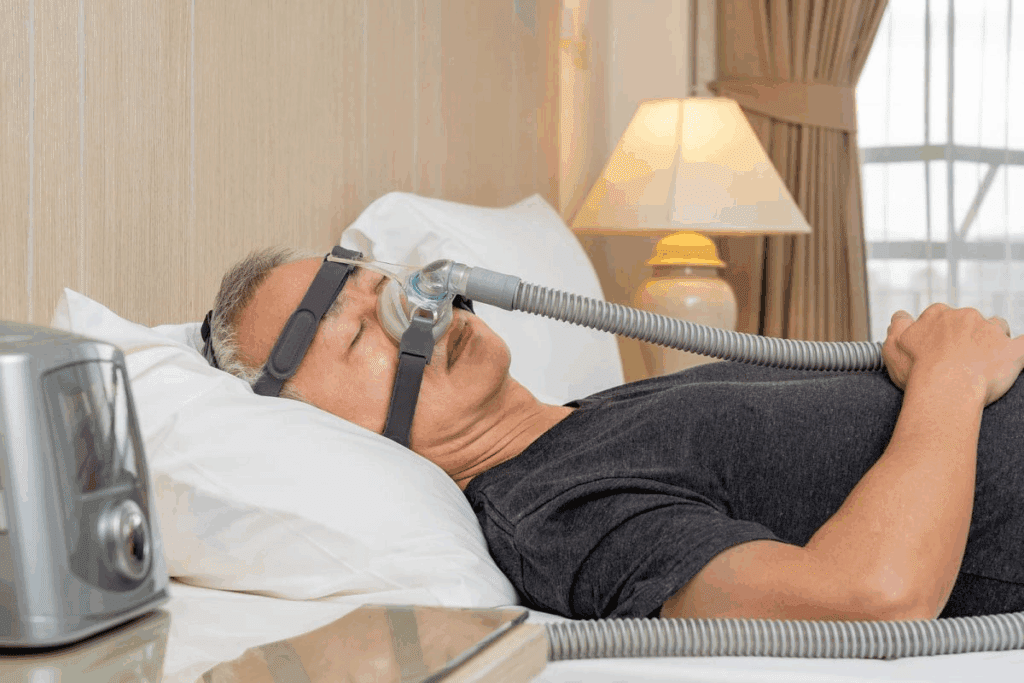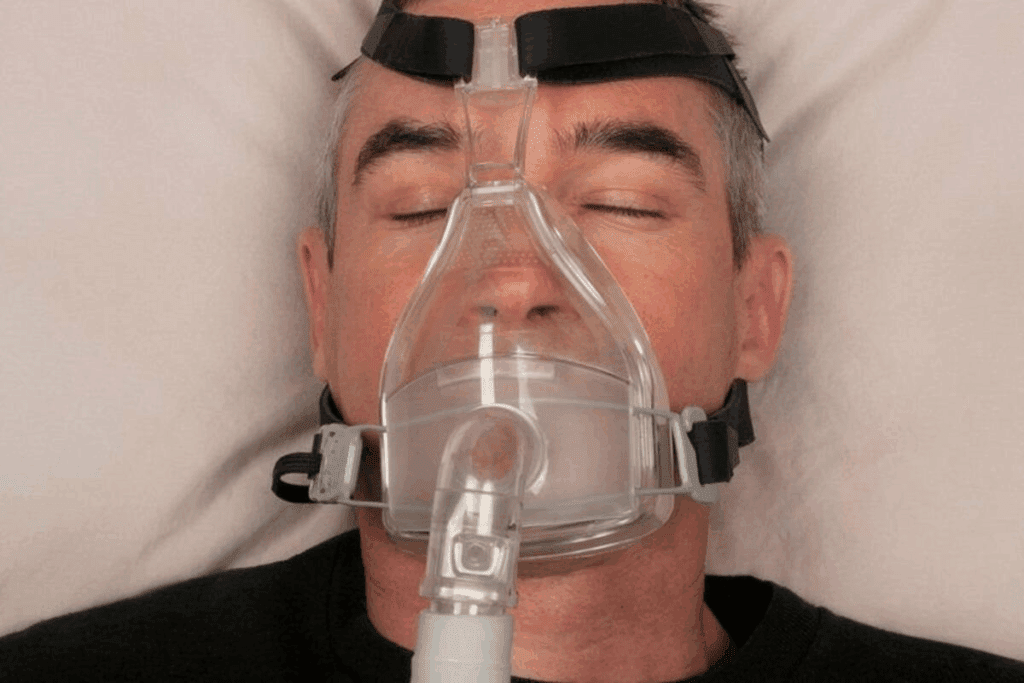Last Updated on October 31, 2025 by Saadet Demir

Sleep apnea vs central sleep apnea: Learn the key differences between the obstructive (OSA) and central (CSA) types of sleep apnea.
At Liv Hospital, we know that sleep disorders can be complex and varied. Sleep apnea affects millions worldwide. It’s not just one condition but includes Central Sleep Apnea (CSA) and Obstructive Sleep Apnea (OSA).
OSA is the most common sleep disorder. It happens when the airway collapses. CSA, on the other hand, is less common but dangerous. It occurs when the brain can’t signal proper breathing.
It’s important to know the differences between these conditions. This helps in getting the right diagnosis and treatment.

Sleep-disordered breathing includes many sleep breathing problems. It covers both obstructive and central sleep apnea. Knowing about these conditions helps us understand their health effects.
Normal sleep breathing is steady and uninterrupted. The brain controls this by adjusting breathing rate and depth. The airway stays open, making breathing easy and ensuring enough oxygen.
Breathing is a complex process involving many systems. The brainstem is key, sending signals to muscles for breathing. When we breathe in, the diaphragm goes down, and the lungs fill with air. Breathing out is easier, with the diaphragm relaxing and the lungs emptying.
Many things can disrupt sleep breathing. Obstruction or neurological issues are common causes. Obstructive sleep apnea (OSA) blocks the airway, while central sleep apnea (CSA) is due to brain problems.
Disrupted breathing can harm sleep quality and lower blood oxygen. This can lead to health issues like heart disease and fatigue. Knowing how these problems occur is key to treating them.

It’s important to know the difference between sleep apnea and central sleep apnea. These sleep disorders can really affect a person’s life. Knowing the difference is the first step to managing them well.
Obstructive sleep apnea (OSA) happens when something blocks the airway, even when you try to breathe. On the other hand, central sleep apnea (CSA) is when your brain doesn’t tell your muscles to breathe.
Here’s a quick summary of each:
OSA is more common, affecting up to 38 percent of people. CSA is less common, affecting 0.9 percent of people over 40. These numbers show why it’s key to understand the difference between these two conditions.
Even though OSA is more widespread, CSA also needs attention. It has complex causes that need careful treatment.
Obstructive Sleep Apnea happens when the muscles in the throat relax. This causes the airway to narrow or block during sleep. It disrupts normal breathing.
When we sleep, the muscles in the throat relax. This can narrow or block the airway. It leads to less airflow or pauses in breathing, called apneas.
Key factors contributing to airway obstruction include:
Several things can increase your chance of getting Obstructive Sleep Apnea. Being overweight or obese is a big risk. So is having a larger neck and being older. Men are also more likely to get it than women.
Major risk factors for OSA are:
Knowing these risk factors and how airways block can help diagnose and treat OSA. We’ll look at how these factors affect patient care next.
Central sleep apnea (CSA) is a complex disorder. It happens when the brain can’t send the right signals to the muscles that control breathing. This is different from obstructive sleep apnea, which is a mechanical issue, not a neurological one.
The brain’s failure to regulate breathing during sleep is at the heart of CSA. This can be caused by many factors that affect the brainstem. The brainstem controls our breathing.
Key Factors Affecting the Brainstem:
These conditions can mess with the brainstem’s normal function. This leads to CSA. Knowing these causes is key to finding good treatments.
CSA can be either primary or secondary. Primary CSA doesn’t have a known cause. Secondary CSA is linked to other health issues or factors.
Characteristics | Primary CSA | Secondary CSA |
Underlying Cause | None identified | Associated with medical conditions or factors |
Common Associations | Rare, idiopathic | Heart failure, stroke, medications, high-altitude sleep |
Treatment Approach | Symptom management | Treating underlying condition |
It’s important to know if CSA is primary or secondary. This helps decide the best treatment plan.
Understanding CSA’s causes and mechanisms helps doctors find better ways to treat it. This makes managing the condition more effective.
To find out if someone has sleep apnea, doctors use a few steps. They start with checking symptoms and then do sleep studies. This way, they can tell if it’s central sleep apnea (CSA) or obstructive sleep apnea (OSA).
The first step is to look at the patient’s symptoms and health history. Signs of sleep apnea include breathing stops during sleep and feeling tired during the day. Doctors also look at the patient’s overall health, like heart disease or high blood pressure.
Key symptoms to look out for:
After checking symptoms, sleep studies are done to confirm the diagnosis. The main tools are polysomnography (PSG) and home sleep testing (HST).
Polysomnography (PSG): PSG is an overnight study in a sleep lab. It tracks brain waves, muscle activity, and heart rate while sleeping. PSG is the top choice for diagnosing sleep apnea because it shows detailed sleep patterns.
Home Sleep Testing (HST): HST is easier and cheaper than PSG. It uses a portable device to record sleep data at home. Though not as detailed as PSG, HST works well for simple OSA cases.
The apnea-hypopnea index (AHI) is key in diagnosing sleep apnea. It counts apneas and hypopneas per hour of sleep. The AHI helps figure out how severe sleep apnea is and if it’s CSA or OSA.
AHI Range | Severity of Sleep Apnea |
0-4 | Normal |
5-14 | Mild |
15-29 | Moderate |
30 or more | Severe |
By mixing initial checks with sleep studies and the AHI, we can accurately diagnose sleep apnea. Then, we create a treatment plan that fits the patient’s needs.
It’s important to know the difference between Central Sleep Apnea (CSA) and Obstructive Sleep Apnea (OSA). Both are sleep disorders, but they have different causes and symptoms.
CSA and OSA differ in how the body tries to breathe during sleep. In OSA, the airway gets blocked, but the body keeps trying to breathe. CSA, on the other hand, doesn’t have this effort because of a brain issue.
Respiratory Effort Patterns:
Condition | Respiratory Effort During Apnea |
Obstructive Sleep Apnea (OSA) | Present, despite airway obstruction |
Central Sleep Apnea (CSA) | Absent, due to neurological factors |
CSA and OSA share some symptoms, but there are big differences. OSA patients often snore loudly, have headaches in the morning, and feel tired during the day. CSA patients might wake up a lot, have trouble sleeping, and feel tired too.
Common Symptoms:
Symptom | OSA | CSA |
Loud Snoring | Common | Rare |
Morning Headaches | Frequent | Less Common |
Daytime Fatigue | Common | Common |
Frequent Awakenings | Less Common | Frequent |
Knowing these differences helps doctors create better treatment plans. They can tailor care to meet the needs of patients with CSA or OSA.
There are many ways to treat obstructive sleep apnea. These include CPAP therapy, alternative devices, and oral appliances. The right treatment depends on how severe the condition is, what the patient prefers, and their specific needs.
CPAP therapy is a common and effective way to treat OSA. It involves wearing a mask over the nose and/or mouth during sleep. This mask delivers a continuous flow of air to keep the airway open.
CPAP therapy can greatly reduce sleep disruptions. It improves the quality of life for OSA patients.
While CPAP is very effective, some patients struggle with it. This is because of discomfort or claustrophobia from wearing the mask. Advancements in CPAP technology have made masks more comfortable. Devices with built-in humidifiers also help.
For those who can’t use CPAP, there are other options. Alternative devices include:
Oral appliances are custom-made devices. They advance the position of the lower jaw, keeping the airway open during sleep. These are good for patients with mild to moderate OSA.
Lifestyle changes can also help. These include weight loss, regular exercise, and sleep position modification. These changes can reduce the severity of sleep apnea and improve health.
In conclusion, treating obstructive sleep apnea involves medical devices, oral appliances, and lifestyle changes. Understanding these options helps patients and healthcare providers manage OSA effectively.
Managing CSA needs a mix of treatments and advanced devices. Each plan is made just for the patient. This ensures they get the best care possible.
CSA often comes from health problems like heart failure or brain disorders. “Treating the underlying condition is key in managing CSA,” sleep experts say. So, finding and fixing these issues is a big part of treatment.
If heart failure causes CSA, better heart treatment can help. This might include medicines, lifestyle changes, or devices that help the heart work better.
CSA treatment also includes special breathing therapies. Adaptive Servo-Ventilation (ASV) and BiPAP (Bilevel Positive Airway Pressure) therapy are two main ones.
ASV is great for CSA patients. It gives pressure support that changes with the patient’s breathing. This helps keep breathing steady and improves sleep.
BiPAP therapy gives different pressures for breathing in and out. It’s more comfortable for some and helps manage CSA well.
Key benefits of these therapies include:
By treating the root causes and using these special treatments, doctors can give full care to CSA patients.
Understanding and managing sleep apnea is key to a better life. With the right diagnosis and treatment, people with sleep apnea can live active and healthy lives. A good approach to managing sleep apnea covers both physical and lifestyle aspects.
Living with sleep apnea means being aware and taking action. It’s important to seek medical help if symptoms don’t go away. For those with central sleep apnea (CSA) or obstructive sleep apnea (OSA), sticking to treatment plans and making lifestyle changes can greatly improve well-being.
By controlling sleep apnea, people can lessen its effects on their daily lives. We urge those affected to work with healthcare professionals to create a personalized management plan. This ensures the best results.
CSA happens when the brain can’t send the right signals to breathe. OSA is caused by something blocking the airway. This is the main difference.
Being overweight, older, and other airway blockages increase your risk for OSA. Knowing these can help diagnose and treat OSA.
To diagnose CSA, doctors use sleep studies like polysomnography. These tests check breathing patterns during sleep to spot CSA.
The AHI is key in diagnosing sleep apnea. It counts how often breathing stops or slows down during sleep. This helps tell CSA from OSA.
For OSA, treatments include CPAP therapy, other devices, oral appliances, and lifestyle changes. These help manage the condition well.
Managing CSA means treating any underlying health issues. Special treatments like adaptive servo-ventilation and BiPAP are used, based on the person’s needs.
Yes, lifestyle changes are important for both CSA and OSA. They help by addressing obesity and improving sleep quality.
Knowing the difference between CSA and OSA is key. It helps in getting the right treatment, as their management strategies are different.
The Central Apnea Index is the number of central apnea events per hour of sleep. It’s important for diagnosing and assessing CSA severity.
Yes, there are primary and secondary forms of CSA. Secondary forms are caused by other medical conditions or factors affecting breathing control.
National Center for Biotechnology Information. (2025). What Is Central Sleep Apnea vs Obstructive Sleep. Retrieved from https://pmc.ncbi.nlm.nih.gov/articles/PMC6883649/
Subscribe to our e-newsletter to stay informed about the latest innovations in the world of health and exclusive offers!
WhatsApp us